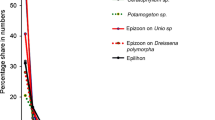Abstract
The hydrobiological research was carried out on the shallow and macrophyte-dominated Lake Budzyńskie (Wielkopolski National Park, Poland). Biometric parameters (such as length of stems and dry weight) of particular plant associations (Charetum tomentosae, Myriophylletum verticillati, Potametum natantis, and Typhetum angustifoliae) were analysed. Additionally, the dry biomass of periphyton obtained from the rinsing of each type of plant was estimated, in order to compare the content of periphyton adequate to 1 litre of water in each particular phytocoenosis. Macrophyte beds with Myriophyllum verticillatum and Chara tomentosa were characterised by significantly higher scale values of periphyton, contrary to the macrophyte beds represented by Typha angustifolia and Potamogeton natans. These results were connected with the differences in the density and the morphological build of particular plant species. However, the analysis of the mean value of the similarity of rotifer community between particular macrophyte stations revealed that the stands of floating and emerged macrophytes, which were of the `sparse' spatial structure and low values of chemical variables obtained from periphyton, were of the highest similarity. A second group, consisting of both species of submerged macrophytes, which was characterised by `dense' spatial structure and high values of chemical variables, was distinguished but the level of similarity of the rotifera community was lower.
Similar content being viewed by others
References
Blindow, I., 1987. The composition and density of epiphyton on several species of submerged macrophytes – the neutral substrate hypothesis tested. Aquat. Bot. 29: 157–168.
Chick, J. H. & C. C. McIvor, 1994. Patterns in the abundance and composition of fishes among beds of different macrophytes: viewing a littoral zone as a landscape. Can. J. Fish. Aquat. Sci. 51: 2873–2882.
Cyr, H. & J. A. Downing, 1988a. Empirical relationships of phytomacrofaunal abundance to plant biomass and macrophyte bed characteristics. Can. J. Fish. Aquat. Sci. 45: 976–984.
Cyr, H. & J. A. Downing, 1988b. The abundance of phytophilous invertebrates on different species of submerged macrophytes. Freshwat. Biol. 20: 365–37.
Dvo?ák, J., 1987. Production-ecological relationships between aquatic vascular plants and invertebrates in shallow waters and wetlands, a review. Ergebn. Limnol. 181–184.
Duggan, I. C., 2001. The ecology of periphytic rotifers. Hydrobiologia 446/447: 139–148.
Eminson, D. F. & B. Moss, 1980. The composition and ecology of periphyton communities in freshwaters. I. The influence of host type and external environment on community composition. Br. Phycol. J. 15: 429–446.
Folsom, T. C. & N. C. Collins, 1984. The diet and foraging behaviour of the larval dragonfly Anax junius, with an assessment of the role of refuges and prey activity. Oikos 42: 105–113.
Gons, H. J., 1979. Periphyton in Lake Vechten, with emphasis on biomass and production of epiphytic algae. Hydrobiol. Bull., 13 (2–3): 116.
Ja?czak, J., B. Brodzi´nska, A. Kowalik & R. Sziwa, 1996. Atlas of the Lakes of Poland. Bogucki Wydawnictwo Naukowe. Pozna?.
Jeppesen, E., Ma. Søndergaard, Mo. Søndergaard & K. Christoffersen, 1998. The structuring role of submerged macrophytes in lakes. Springer-Verlag Berlin.
Jürgens, K., H. Arndt & K. O. Rothhaupt, 1994. Zooplanktonmediated changes of bacterial community structure. Microbial Ecol. 27: 27–42.
Kompowska, A., 1997. Wstepna ocena zasiedlenia przez mieczaki dwoch zbiorowisk Characeae w jeziorach Insko i Gardzko (The estimation of molluscs inhabitation of two Characeae communities in Insko and Gardzko lakes). Proceedings of 17 Symposium of Polish Hydrobiological Society. Pozna?: 202–203.
Krebs, Ch. J., 1989. Ecological Methodology. Harper & Row, New York.
Kuczy?ska-Kippen, N., 2001. Struktura przestrzenna zespolów Rotifera w wybranych fitocenozach roslinnosci zanurzonej i szuwarowej Jeziora Budzy?skiego (The spatial structure of rotifera communities of the submerged and rush vegetation phytocoenosis of Budzy´nskie lake). Ph.D. thesis, mnsc.
Leibold, M. A., 1991. Trophic interactions and habitat segregation between competing Daphnia species. Oecologia 86: 510–520.
Masty?ski, J., W. Andrzejewski & M. Czarnecki, 2001. Ichtyofauna of the Wielkopolski National Park. In Burchardt, L. (ed.), Water Ecosystems of Wielkopolski National Park. Wydawnictwo Naukowe UAM, Pozna?: 329–338.
Messyasz, B., 2001. The characteristics of the phycoflora structure of lakes and ponds in the Wielkopolski National Park. In Burchardt, L. (ed.), Water Ecosystems of Wielkopolski National Park. Wydawnictwo Naukowe UAM, Pozna?: 109–148.
Paterson, M., 1993. The distribution of microcrustacea in the littoral zone of a freshwater lake. Hydrobiologia 263: 173–183.
Pieczy?ska, E., 1988. Rola makrofitow w ksztaltowaniu trofii jezior. (Effect of macrophytes on lake trophy).Wiadomosci ekologiczne 34 (4): 375–404.
Raffaelli, D., S. Hall, C. Emes & B. Manly, 2000. Constraints on body size distributions: an experimental approach using a smallscale system. Oecologia 122: 389–398.
Scheffer, M., 2001. Ecology of Shallow Lakes. Kluwer Academic Publishers, Dordrecht, The Netherlands.
Scheffer, M., A. A. Achterberg & B. Beltman, 1984. Distribution of macroinvertebrates in a ditch in relation to the vegetation. Freswat. Biol. 14: 367–370.
Smiley E. A., Tessier A. J. 1998. Environmental gradients and the horizontal distribution of microcrustaceans in lakes. Freshwat. Biol. 39: 397–409.
Sokal, R. R., 1961. Distance as a measure of taxonomic similarity. Syst. Zoolo. 10: 71–79.
Standard Methods for the Examination of Water and Wastewater, 1992. XVIII-th edition. American Public Health Association, New york.
Theil-Nielsen J. & M. Søndergaard, 1999. Production of epiphytic bacteria and bacterioplankton in three shallow lakes. Oikos 86: 283–292.
Walsh, E. J., 1995. Habitat-specific predation susceptibilities of a littoral rotifer to two invertebrate predators. Hydrobiologia 313/314: 205–211.
van den Berg, J., H. Coops, R. Noordhuis, J. van Schie & J. Simons, 1997. Macroinvertebrate communities in relation to submerged vegetation in two Chara-dominated lakes. Hydrobiologia 342/343: 143–150.
Author information
Authors and Affiliations
Rights and permissions
About this article
Cite this article
Kuczyńska-Kippen, N., Nagengast, B. The impact of the spatial structure of hydromacrophytes on the similarity of rotifera communities (Budzyńskie Lake, Poland). Hydrobiologia 506, 333–338 (2003). https://doi.org/10.1023/B:HYDR.0000008542.76373.44
Issue Date:
DOI: https://doi.org/10.1023/B:HYDR.0000008542.76373.44




